How Jay-Z and the 40/40 Club Ruled NYC Nightlife
- Oops!Something went wrong.Please try again later.
- Oops!Something went wrong.Please try again later.
- Oops!Something went wrong.Please try again later.
- Oops!Something went wrong.Please try again later.
- Oops!Something went wrong.Please try again later.
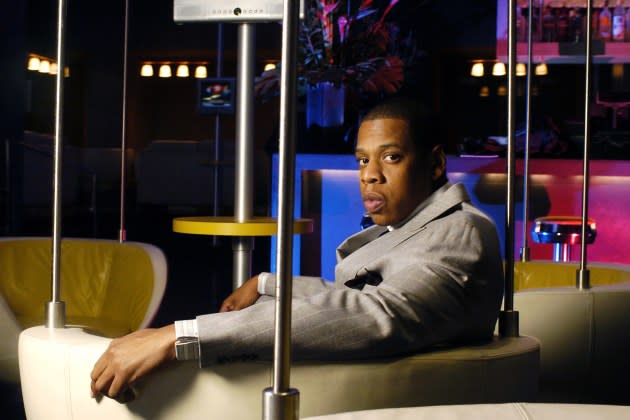
It’s midday at the dawn of the 21st century — Wednesday, June 18, 2003 — in New York City’s Flatiron District, the gateway between uptown wealth and downtown cool. We’re on the west side of Madison Square, and 33-year-old Shawn Carter is busy. Several hours from now, he’ll host a massive party that shuts down West 25th Street and attracts celebrities like his longtime friend and business partner Dame Dash, Heavy D, Magic Johnson, Nets point guard Jason Kidd, and golfer Ricky Barnes.
Network TV correspondents stream in, hungry for a story in the dog days of summer: WB11, UPN, ABC, CNN, NBC, and Billy Bush from Access Hollywood, camera-ready with their crews, with tight windows to speak with the rapper who has become a legend in an astonishingly brief period of time. In November, on the first single off of The Black Album, Carter will encourage his listeners to “Change Clothes,” to leave behind the uniform of baggy jeans, backward hats, and XXL T-shirts manufactured and sold by his own $204 million clothing label, Rocawear, but he’s in that exact fit right now: A thick, fresh, off-the-rack white T-shirt, a backward Rocawear fitted hat with X-piping, baggy denim shorts, white sneakers, and a watch with a chunky bezel.
More from Rolling Stone
Beyoncé Becomes First Black Woman to Nab Number One Country Album With 'Cowboy Carter'
Paul McCartney 'So Happy' With Beyoncé's 'Magnificent' Version of 'Blackbird'
Carter is ready, but the cavernous, 12,000-square-foot space he’s in isn’t. Around him, an army of electricians run BX and coaxial cable in open walls, contractors balance on stepladders, white couches are still wrapped in plastic, bathrooms are unfinished. It’s a sprint to the end zone this evening, when the business, a new sports bar called the 40/40 Club, will throw its opening party.
When he’s asked, over and over again, “What will it take to get inside the new space?” he responds: “You just have to have the right vibe. We have the right to be very selective.”
His answer evokes countless nights in the Eighties and early Nineties, when he was likely left out in the line, waiting with the rest of us herbs and schmucks. But now, the kid from Marcy has his own rope, his own door, and his own club. Just off a legendary succession of six platinum albums, this will be his headquarters, his laboratory, his playground, his office suite, for the next two decades, where with a select team around him, he’ll complete the leap from businessman to a business. The name is a reference to a rare feat in baseball: Hitting 40 home runs and stealing 40 bases in a single season. It’s a feat of both power and speed, two attributes Carter emulates in his career, his business, and his life.
Twenty years from now, the Brooklyn Public Library will have his lyrics wallpapered over its facade. In 16 years, he will be rap’s first billionaire. In five, he’ll be married to his then-girlfriend, pop star Beyoncé Knowles. By the end of the year, he will be “retired” from rap, and soon after, installed as the CEO of Def Jam. But today is press day, and the lifetime hustler has a business to pitch.
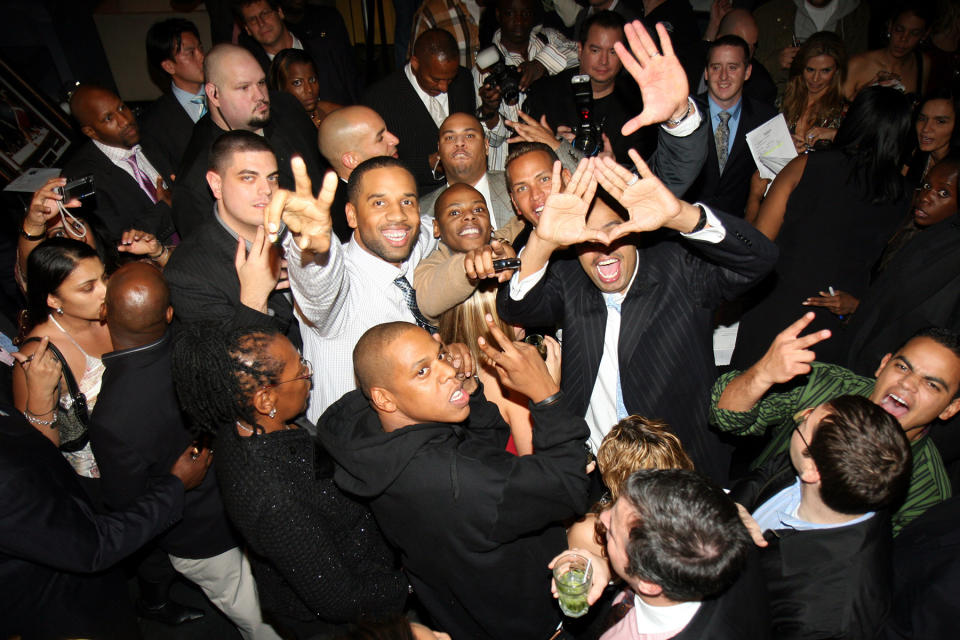
THE IDEA OF THE 40/40 Club was almost quaint, in retrospect, a concept a teenager might dream up and scribble on the back of a napkin: A luxury sports bar that’s also a nightclub. The key with Carter, as it always has been, was in execution.
“He wanted to give the tours to the press. He was excited to show it off,” says Ron Berkowitz, the CEO and founder of Berk Communications, who ran PR for 40/40 from its inception. “A lot of people talk about, ‘Oh, a celebrity slapped their name on this.’ No, this guy was involved in everything.… He picked out the fucking bar. He picked out the couches.… Every nook and cranny of that place, he was a part of, and he was proud of what he’d built.”
But in 2003, the 40/40 Club was a tricky proposition — at least on paper. Before the opening party, police came by for a walk-through, because they were shutting down 25th Street for the event. The cops were skeptical, a source tells me, saying they thought the night would go badly, attracting disruptions or worse.
It was a time when the Hip-Hop Cops ruled New York, and live rap performances were practically outlawed in the city limits. Rap and rappers were seen as magnets for trouble. Other “rap establishments,” like Diddy’s Justin’s, also in Flatiron, were regarded much in the way a New Yorker review from 2003 relates: Colorful but chaotic spaces, regularly running out of popular menu items and prone to last-minute closures according to the whims of high-profile owners.
But the launch of 40/40 was flawless. Those same skeptical cops returned to the club after the party and told the source, “That was incredible. You guys did a great job.”
After the opening, the bar was “an instant hit.” So much so that two years later, a franchise was born, with an offshoot in Atlantic City, New Jersey, and subsequent (short-lived) branches in Las Vegas, the Atlanta airport, and Brooklyn’s Barclays Center arena (where a lounge still carries the name). It scratched an itch for a certain New York City nightlife demo. The space was adaptive, all things to all people: Laid-back while still feeling luxurious and stylish, at once accessible and exclusive.
The allure of proximity to Carter and his circle was the main draw. Once you got through the heavy, fortress-like, wood-panel doors with silver baseball-bat handles off of 25th Street, you might see J. Cole performing on the stairs or Alonzo Mourning hanging out alongside Dame Dash, sharing plates from the menu of greasy, salty, beer-friendly sports-bar standards. Any random day over two decades, Carter and his friends might be in a visible roped-off area, or lingering somewhere in the far recesses of the club.
“You could see him and Beyoncé, and all these people would be trying to go over there to kiss the ring,” says Jeff Rosenthal of ItsTheReal and the narrative hip-hop podcast The Blog Era.
“People always thought, ‘It’s 40/40. A celebrity is probably going to show up, because celebrities were so comfortable at 40/40,” 40/40 and LVMH events promoter J’Vonn Forbes says. “It could be Rihanna, Jay-Z, Beyoncé, Lil Uzi, or professional basketball players.”
For an early redesign of the club, the late architect Jeffrey Beers and his team took inspiration from classic New York City architecture, along with Carter’s own style. “We wanted the overall feel of the space to be one of sophistication and urban luxury,” Beers said, “devoid of the coldness and pretentiousness that was found in many traditional nightclubs of that era.”
There was an amber, resin-top bar, leather-upholstered banquettes on bleacher-style rises of polished white marble, walnut millwork, and an installation of custom-made baseball bats pin-mounted in a rhythmic pattern. It was all dark wood and soft leather bathed in warm light, like being inside a rich friend’s mansion, or their humidor. It was laid out on an ascending slant, with rafters leading up from the bar where standing-room guests could congregate, but above them, there were elevated seating areas with clear sightlines to the many mounted TVs. DJs spun rap — anything from classic East Coast to Young Thug.
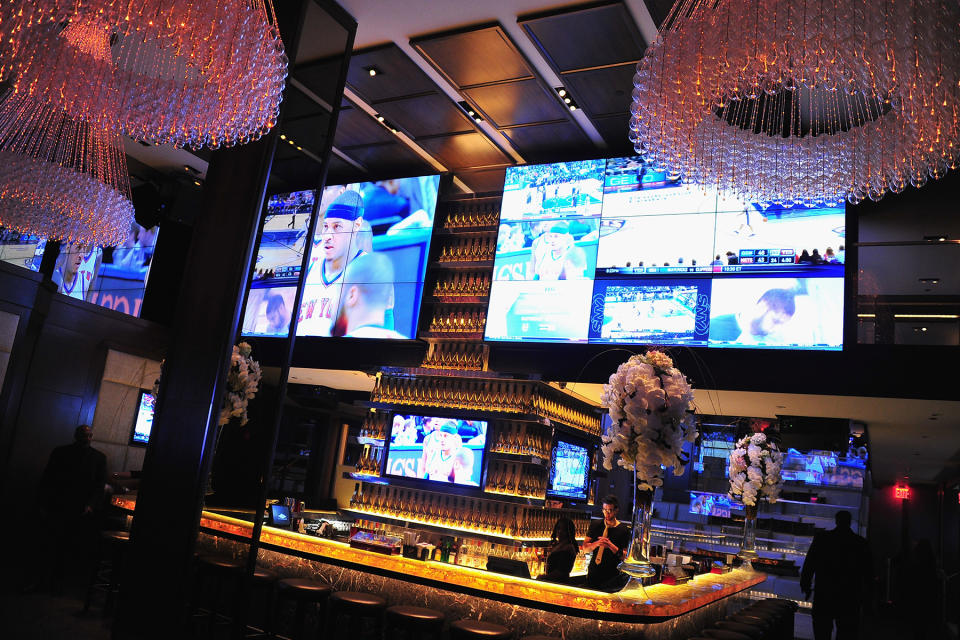
GQ senior entertainment editor and self-dubbed “Jay-Z scholar” Frazier Tharpe compares the space to the Bamboo Lounge, where at the opening of Goodfellas a giddy camera takes us on a tour through a packed room, introducing us to the colorful crew of close-knit characters a young Henry Hill was seduced by. “My earliest memory of that place is being in there when it was so new that [Jay-Z] was actually in there,” Tharpe says. “I went for lunch, and he was fully in there, just like sitting on the steps on his BlackBerry.”
Even if there were no stars to see at the bar, there was always the possibility they were hanging somewhere in the back, around a corner. Beyond the main seating area, up the stairs, the club was tiered and segmented, like a basketball arena or a pyramid or a great ship. Labyrinthine corridors lined with priceless sports memorabilia led to intimate chambers, luxury boxes, where athletes, musicians, celebrities, and various kingmakers congregated in private rooms. (In descending order: the Jay-Z Lounge, the Elite Lounge, the Coaches Lounge, and a semiprivate Mezzanine, with its own lounges and bar on a second-floor catwalk.) For the super wealthy and famous, these spaces could be accessed discreetly, by side doors and back stairwells.
The private rooms had different price points, and packages you could purchase. There was a minimum spend and a room-rental fee. Each space was personalized with different features, no aspect left unconsidered or half-baked.
“The rooms upstairs were a different mode,” Tharpe says. “The average person could go there and not know that Meek [Mill] was upstairs.” Forbes seconds this: “I would laugh because people will walk in and be like, ‘Oh, it’s only 30 people in here.’ Because that’s what you would see, right? And if you were my close friend, I would say, ‘Oh, let’s go outside,’ and I’ll take you outside. You may see a car that costs, like, $400,000. And I’ll say, ‘The person that’s driving that car is in here. They walked in through the back door, went up some back steps, and went into a private room.’”
Locating the club in New York’s historical nightlife pantheon, Berkowitz says, “Studio 54 was once the place where everybody could be seen, and for athletes and for musicians and for some celebrities, [40/40] was that. It was a place where they could go and be comfortable and nobody would bother them, but there’d be regular people there, because the regular people knew this was their place, too. There’s very few places where you can mix and mingle like that. The stadium seating is out in the open. So when you’re sitting at the bar and Beyoncé or Kevin Durant or Shaquille O’Neill or, you know, President Obama are sitting behind you, you’re there. It’s not hidden.”
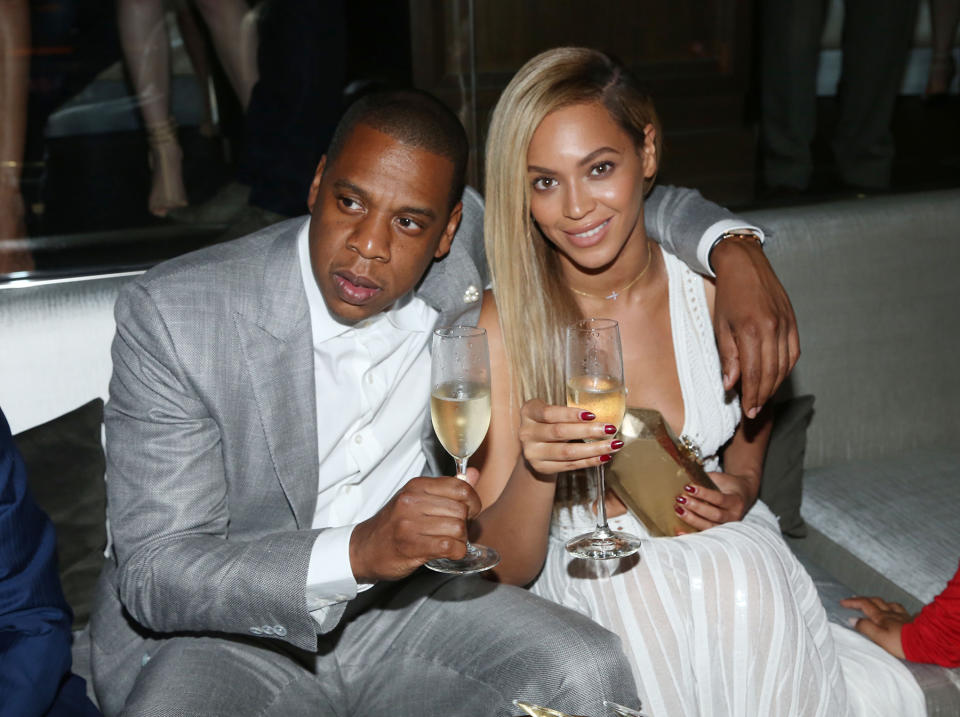
Berkowitz isn’t being hyperbolic when he name-drops the former president. The 40/40 Club was the site of a highly publicized, $4 million closed-door fundraiser during Barack Obama’s 2012 reelection campaign. It was a headline-garnering spectacle at the time, with tabloids attempting to use the rapper-owned venue’s opulence to paint Obama as an out-of-touch-elitist, focusing on the $105,000 Armand de Brignac tower as proof. Berkowitz says that, like all things 40/40, it was both a once-in-a-lifetime experience and nothing special.
“I remember doing the Secret Service walk-throughs,” Berkowitz says. “There was an incredible buzz in the air. And then, Obama was the president, but he was this regular dude. He just wanted to talk sports and hang out. It shows the power of Jay-Z and Beyoncé that they could bring those people in. I don’t think that happens a lot. I think that a lot of those big-money fundraisers happen in people’s houses in the Hamptons, or their apartments, and this club serving as the backdrop, that was pretty special. It hopefully helped in some small way to put Obama in the White House another four years.”
CARTER’S CAREER HAS ALWAYS carried a streak of contrarianism. His whole career — starting with him trying to get singles from Reasonable Doubt played on Hot 97 in 1996 — he was bet against, told “no” over and over again. Mentors didn’t believe he could succeed without their guidance and partnership, brands devalued what he brought as a spokesperson, so Carter showed them he could do it himself.
Back in 2003, Carter had hit every milestone, and broken every record. He’d taken over Summer Jam, earned five mics in The Source, and arguably had the longest and most dominant run as “King of New York” that rap had ever seen. With The Black Album, his elevation to head of Def Jam the next year, and his subsequent split from business partners Dame Dash and Kareem “Biggs” Burke, Carter signaled he was moving on to the next period of his life, the mogul in his post-artist era. This included the club he’d make his retirement HQ. It was a familiar play.
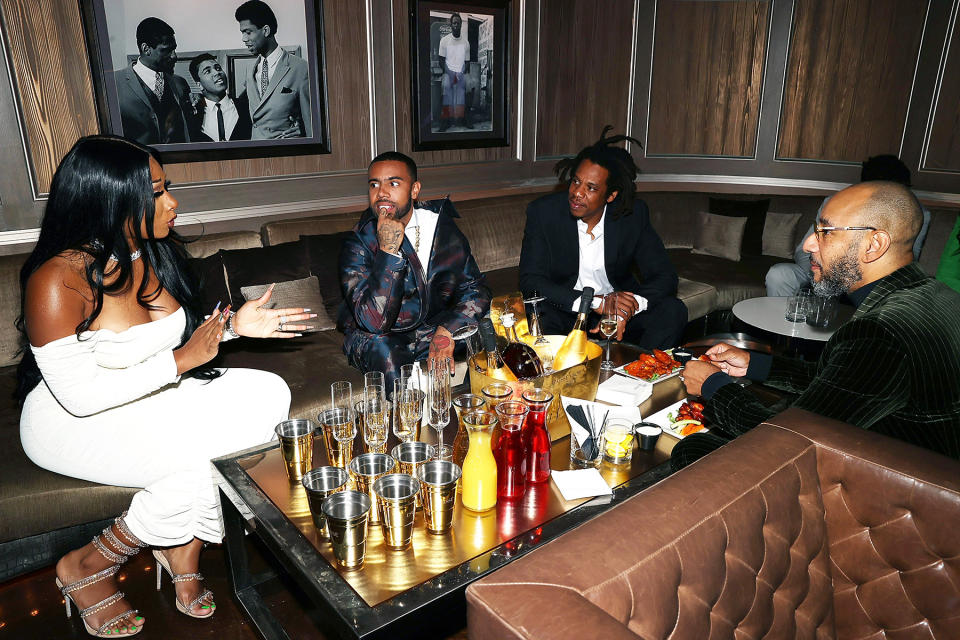
The 40/40 Club followed in a long and proud 20th-century tradition: the celebrity clubhouse. Robert De Niro himself practically imprinted on TriBeCa with his onetime destination grill. Mickey Mantle had a sports bar on Central Park South. Michael Jordan had a steakhouse chain. What made the 40/40 Club unique was what it represented: rap remixing this concept and adapting it to its time, for people and a culture that weren’t supposed to be included in this tradition. But it wasn’t just a place to grab a drink — for Roc Nation, the entertainment company and music label Carter founded in 2008, it was a place to recruit and hold court.
“For me and my guys, inside and outside Roc Nation, everybody wants their Cheers, and for us, that was 40/40,” says Lenny Santiago, a.k.a. Lenny S, the senior vice president of Roc Nation. “I brought a lot of people there to see Jay. We had a lot of meetings. I’d bring Swizz, I’d bring Timbaland. Different people, artists, producers that Jay wanted to get up with. If we weren’t at the studio or the office, that’s where we were.”
Same goes for Roc Nation Sports, the sports agency that currently boasts more than 100 clients — starting with former Yankees second baseman Robinson Cano, the agency’s first, splashiest client. (Carter was credited with landing Cano his then-record $240 million, 10-year contract with the Seattle Mariners in 2013.)
“I think the 40/40 Club was a building block to his ambitions in sports,” says journalist Zach O’Malley Greenburg. “The club augmented their relationships with athletes.” Carter and his team began Roc Nation Sports as a partnership with talent agency CAA (and later dissolved that partnership after two years). But the seeds for the agency were planted at 40/40, a full decade before its 2013 launch. In his book on Carter’s financial ascent, Empire State of Mind: How Jay-Z Went From Street Corner to Corner Office, O’Malley Greenburg revisits the summer the club opened, when Carter sponsored a team for the Entertainers Basketball Classic in Harlem’s Holcombe Rucker Park, a high-profile tournament that attracts street-ball legends and professional ringers alike. Carter showcased his rare skill for cross-promotion. The team he assembled worked as an advertisement for his newly opened club, and his newly launched S. Carter Reebok basketball sneaker. Carter recruited Lamar Odom, Kenyon Martin, Tracy McGrady, LeBron James, Sebastian Telfair, and Jamal Crawford. For each game, this all-star squad would be ferried from the 40/40 Club to the park, then back to the 40/40 for an afterparty, in a bus papered with S. Carter sneaker ads. “What a great way to build buzz around a place, to get paparazzi and free publicity,” O’Malley Greenburg says.
“It comes down to the ability to recruit players,” MLB agent and former team owner Jeffrey Moorad says. Tom Condon, Carter’s early partner in Roc Nation Sports, and CAA’s head of football, adds: “Certainly, from our competitors’ standpoint, they’ve got to be concerned. Jay-Z and Roc Nation bring a lot to the party. He’s got reach to places that probably are different from what, typically, CAA is involved in.”
40/40 became the place where Carter’s products and marketing campaigns were workshopped, and tested. Consider the majestic, 20-foot-tall, multimillion-dollar golden temple mount composed of bottles of his Armand de Brignac, “Ace of Spades” champagne. It’s not just a gleaming centerpiece that reinforces the quality of being in the Book of Exodus, it was one of the greatest billboards on Earth.
If you were at 40/40 in the early 2000s, you likely also sipped on Ace of Spades. Carter soft-launched the champagne brand in 2006 with his post-“retirement” comeback music video for “Show Me What You Got.” That video essentially served as a commercial for his new champagne line. At one point in the video, we see Carter being offered a bottle of Cristal, which he waves off, opting for a bottle of Ace of Spades.
The champagne, his cognac brand, D’Ussé, and 40/40 were mainstays in his rhymes. He also shot the music video for his 2007 anthem “Roc Boys” in the hallways and stairwells, on the dance floor, at the bar, and in the kitchen of the club, which once again plays like a commercial. “It was an aspirational sports bar,” O’Malley Greenburg says, “while at the same time being a marketing vehicle for something that’s way more lucrative for him.”
LAST SUMMER, THE ANNOUNCEMENT went out. 40/40’s Flatiron flagship would be closing — and reopening somewhere else in Manhattan in February 2024. A few months later, that date was pushed back to 2025.
The 40/40 Club may fade into the recesses of Carter’s illustrious history, a footnote in the forensic accounting of his fortune. But the comparatively small business venture was arguably the spine of his ambition, facilitating the rest of his ventures by proving he could leverage his personal brand, and, along with his partners in the club — Desiree Perez and “OG” Juan Perez — run a company, one that grew him into the chessmaster and one-man empire he is today.
“Jay’s a person that has constantly shifted and changed the culture,” event promoter Forbes says. “So for him to have a club that has a run for this long, it’s something that everybody who looks at that man would be like, ‘Oh, I can see him doing that’ — because that’s who he’s been for years. No matter if it was Rocawear, or Ace of Spades, he was one of the first rappers to be in all of those spaces. For a club to last that long — 20 years that primarily catered to hip-hop culture — is amazing. In New York City, typically you have a three-year run.”
Carter never stopped going to the club — in 2021, he was at 40/40 for a red carpet, starry celebration of its 18th anniversary. And just months before it closed for good, Papoose hosted a Hip Hop 50 celebration with New York rap royalty, from Jim Jones to Fabolous to Ja Rule, in attendance.
But today, the idea of the rapper-owned club or restaurant is greatly transformed. The new goal in the age of the rapper-mogul is more aligned with Nas, who was a ground-floor investor in burgeoning chicken-and-waffles behemoth Sweet Chick, or Rick Ross’ WingStop, which currently boasts more than 30 franchises nationwide. Carter himself is in on this action, as an investor in the salad chain Sweetgreen, trading the era of black tie and tails, of steak, lobster, and bottle service, spending stupid money with your glamorous friends in public, to a capitalist endgame of accumulating interest by the açai bowl.
The 40/40 Club bridged a moment in nightlife, between when being out on the floor, or at the corner table, was the thing to do, whereas now you pay for exclusivity, to be both outside and out of sight, at “scenes” like Michael B. Jordan’s Lower East Side of Manhattan railroad hot spot Las’ Lap. Today, if you’re out in public, you’re also going to be on the internet.
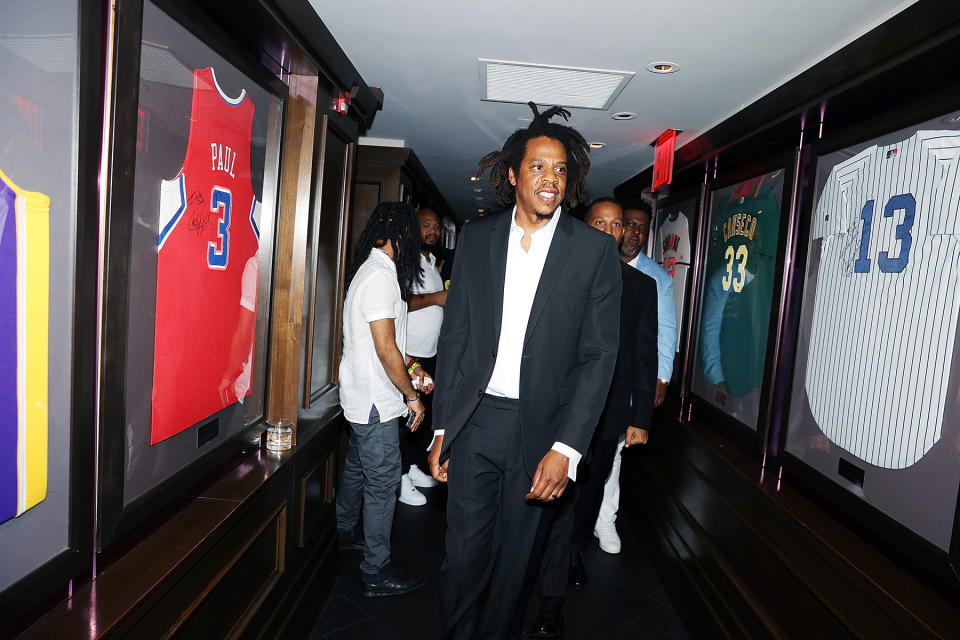
CERTAIN ADDRESSES IN NEW YORK are cursed and others are blessed. The corner of 25th and Broadway is the latter, home to the 40/40 Club for 20 years; long before that, it was occupied by a portion of the Hoffman House, a 19th-century palace hotel that was a residence, a place to eat steak, smoke cigars, and bet on college football for presidents, power brokers, and celebrities. It’s always served as a New York pressure point, a nerve center. The 40/40 Club now enters into this history, part of this great lineage. It’s hard to imagine a worthy successor, but we might have said the same thing in 2003.
A few months ago, I visited that hallowed corner, the old just-closed 40/40 space. The windows had already collected a film of dust, and a thin sheet of raw drywall was put up inside the space, blocking the view of the interior, but someone had knocked a chunk of drywall out, and if you squat, and squint in the right light, they left a rustic porthole you can use to peer into the largely undisturbed space. There was mellow-gold underlighting still on, casting a haunted glow against the walls, the wood paneling and the moldings, and the marble. You could see that dramatic staircase where Barack Obama, and Warren Buffet, and Memphis Bleek once sat.
I stepped back and looked at the corner, and the park beyond it. It was the golden hour, and I saw the tourists, blinkered and stumbling around, conferring with their phones in search of the original Shake Shack or Eataly or the Lego Store, who once flocked to this space for a glimpse of greatness. The commuters, just off work and rushing to make trains uptown or downtown or out of the city or to a welcoming, familiar bar and a dirty martini, are either unaware or unconcerned with the fossil they were breezing past. Above those enormous doors was the outline of where the 40/40 logo had hung for 20 years, and for a moment, the sign returned, glinting in the sun against the wood grain, and I could hear the ghosts of the club’s afternoon crowd, gathered for a final happy hour together. And I could see the club as Shawn Carter once did, as a young man and artist on the precipice of his new life, for the first time.
Best of Rolling Stone

